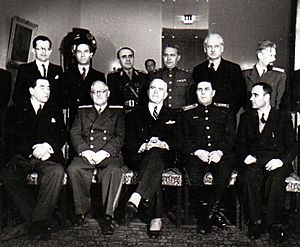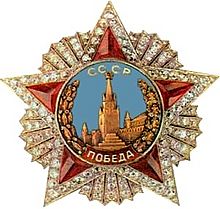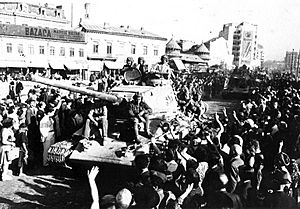Soviet occupation of Romania facts for kids

The Soviet occupation of Romania was a time from 1944 to August 1958. During this period, the Soviet Union kept a large number of soldiers in Romania. The areas of Romania that became part of the Soviet Union in 1940 are discussed in another article: Soviet occupation of Bessarabia and Northern Bukovina.
In 1944, during World War II, the Soviet Army moved into northwestern Moldavia. This happened because of fighting between April and August, while Romania was still an ally of Nazi Germany. The rest of Romania was occupied after the country switched sides in the war. This change happened because of a royal coup led by King Michael I on August 23, 1944. On that day, the King announced that Romania would stop fighting the Allies. Romania also agreed to join the war against the Axis powers. Since no official peace offer had been made yet, the Red Army occupied most of Romania as enemy land. This was before the Moscow Armistice was signed on September 12, 1944.
The Armistice Agreement and later the Paris Peace Treaties of 1947 made it legal for Soviet troops to stay in Romania. Their presence lasted until 1958. At its highest point in 1946, there were about 615,000 Soviet soldiers in Romania.
The Soviets and Romanian communists called the events of August 1944 the "liberation of Romania by the glorious Soviet Army." August 23 (the day of the 1944 coup) was even celebrated as Liberation from Fascist Occupation Day. However, many Western and Romanian anti-communist groups call it the "Soviet occupation of Romania." Some use this term for the entire period from 1944 to 1958.
Contents
How the Occupation Began
After giving up Bessarabia and Northern Bukovina to the Soviets in 1940, Romania joined forces with Nazi Germany. Romania then declared war on the Soviet Union. Romanian soldiers entered World War II in June 1941 as part of Operation Barbarossa. They were under the command of the German High Command. After taking back the land the Soviet Union had taken in 1940, Romanian troops moved into Southern Ukraine. But Romania's war in the east ended badly, especially at the Battle of Stalingrad.
By late 1943, the Red Army had taken back most of its own land. It then moved west beyond the Soviet borders to defeat Nazi Germany and its allies. This is when Soviet forces entered Romania and occupied Northern and Eastern Moldavia.
On August 23, 1944, King Michael, with support from all major political parties, started a coup d'état. This overthrew the pro-Nazi government of Ion Antonescu. It also put the Romanian Army on the side of the Allies. King Michael was the last monarch behind the Iron Curtain to lose his throne, which happened on December 30, 1947.
The coup helped the Red Army move quickly into Romania. It also allowed the combined Romanian and Soviet armies to free the country from German control. Since no armistice was signed right away, Soviet troops still treated Romanians as an enemy. The armistice was signed three weeks later, on September 12, 1944. Its terms were mostly decided by Moscow. The coup was seen as Romania's "surrender" to the Soviets and the other Allies. After King Michael ordered a ceasefire, between 114,000 and 160,000 Romanian soldiers were taken as prisoners of war by the Soviets without fighting back. They were forced to march to prison camps in the Soviet Union. Some survivors said in a 2004 film that up to a third of these prisoners died on the way.
By September 12, the Red Army already controlled much of Romania. Under the Armistice Agreement, Romania came under an Allied Control Commission. This group had members from the Soviet Union, the United States, and the United Kingdom. However, the Soviet military had the most power. Bessarabia and Northern Bukovina were again made part of the Soviet Union.
Some historians, like Mădălin Hodor and Vadim Guzun, have said that "the USSR occupied, broke apart, and made Romania Soviet. Red Army cruelties cannot be erased with offensive statements that disagree with the truth."
Important Agreements

The Armistice Agreement
The Armistice Agreement stated that the Allied Control Commission would be based in Bucharest.
According to Article 14 of the Armistice Agreement, two People's Tribunals were set up. These courts were meant to try people suspected of war crimes. One was in Bucharest, and the other in Cluj.
The main people who signed the armistice were:
- For the Allied powers: Marshal R. Y. Malinovski, representing the Soviet High Command. He was authorized by the governments of the United States of America, the Soviet Union, and the United Kingdom.
- For Romania: Minister of State and Justice L. Patrascanu, Deputy Minister of Internal Affairs General Dumitru Dămăceanu, Prince Stirbey, and Mr. G. Popp.
Paris Peace Treaties, 1947
The Armistice Agreement ended on September 15, 1947. This was when the Paris Peace Treaty with Romania officially started.
The Romanian group at the Paris Conference was led by Foreign Minister Gheorghe Tătărescu. The Peace Treaty with Romania was signed on February 10, 1947. It took place in the Salon de l'Horloge at the French Foreign Ministry. For Romania, the four signers were Gheorghe Tătărescu, Lucrețiu Pătrășcanu, Ștefan Voitec, and Dumitru Dămăceanu. For the Allied powers, signers included United States Secretary of State James F. Byrnes, Soviet Foreign Minister Vyacheslav Molotov, and British Secretary of State for Foreign and Commonwealth Affairs Ernest Bevin.
Soviet Troops in Romania (1944–1956)
| Date | Number of Troops |
|---|---|
| May 8, 1945 | 80,000 |
| November 1, 1945 | 500,000 |
| January 4, 1946 | 420,000 |
| March 1, 1946 | 615,000 |
| June 1, 1946 | 400,000 |
| November 1, 1946 | 240,000 |
| 1947 | 60,000 – 130,000 |
| May 1 – July 1, 1948 | 35,000 |
| October 1, 1948 | 32,000 |
| July 1, 1949 | 28,000 |
| October 1, 1949 | 19,000 |
| January 1, 1950 | 32,000 |
| April 1, 1950 | 33,000 |
| September 1, 1950 – September 1952 |
32,000 |
After the Armistice Agreement in 1944, Soviet troops took over all of Romania. Estimates for the number of troops vary. British military officials thought there were between 750,000 and 1 million. The Romanian General Staff estimated between 1 and 1.5 million. Many Western diplomats believed there were over 1 million Soviet troops.
On November 8, 1945, King Michael's name day, an anti-communist protest happened in front of the Royal Palace in Bucharest. Force was used, and dozens of people were hurt. Soviet officers stopped Romanian soldiers and police from shooting civilians, and Soviet troops brought back order.
The table on the right shows the estimated number of Soviet forces in Romania from VE Day (May 8, 1945) to 1952. This includes air, navy, ground, and security troops.
In the second half of 1946, more than half of the Soviet Air Forces were outside the USSR. The largest groups were in Poland and Romania, with 2,500 planes in each country. The number of troops reached a high of 615,000 in March 1946. But they were reduced after the Peace Treaty was signed in 1947. By the end of 1946, Soviet units in Romania were in four main areas: Craiova–Slatina, Sibiu–Alba-Iulia, Constanța, and Brăila–Focșani. From May 1948 until October 1956, troop levels stayed fairly steady. There were two full divisions, plus support units, making up about a third of another division.
Even though the Austrian State Treaty in 1955 removed the official reason for Soviet troops to be in Romania, Premier Gheorghe Gheorghiu-Dej said they would stay. He stated they would remain as long as foreign soldiers were in West Germany.
Soviet troops in Romania also helped stop the Hungarian Revolution in November 1956. At that time, Romanians were not allowed into Soviet troop facilities in Romania.
Changes to the Romanian Army
| Type of Force | Number of Troops |
|---|---|
| Land forces | 120,000 officers and troops |
| Anti-aircraft forces | 5,000 officers and troops |
| Naval forces | 5,000 officers and troops |
| Air forces | 8,000 officers and troops |
| Total | 138,000 officers and troops |
The Soviet occupation led to a complete change of the Romanian People's Army. This was overseen by Soviet Army representatives. The Paris Peace Treaty limited the Romanian army to 138,000 people (officers and troops). However, under Soviet occupation, the army grew much larger than this limit. This happened because more Romanians were made part of the military. By 1953, the regular army had about 300,000 soldiers. Reserve forces had about 135,000. "Interior" forces, like border guards, had over 325,000.
At the start of these changes, people who supported Germany were removed from the Romanian armed forces. In 1944–45, two divisions were formed from Romanian volunteers. These were former prisoners of war who had been trained in the Soviet Union. They also included Communist activists like Valter Roman. These divisions were the Tudor Vladimirescu Division and the Horea, Cloșca și Crișan Division. They became the core of the new Romanian Army under Soviet control. Once the Romanian Communist Party took power, 30% of officers and non-commissioned officers were removed from the military. These were mostly experienced soldiers who might have opposed the Sovietization of the Army.
After the Romanian Workers' Party took political power, the Romanian army became fully Sovietized. This was supervised by the new Minister of Defense, Emil Bodnăraş. This change meant adopting the Soviet way of organizing the military and politics. It also changed how the army fought and defended the country. This happened as Romania became part of the Soviet plan at the start of the Cold War.
Soviet officers became advisers to oversee the army's reorganization. They held important leadership and monitoring roles in state institutions. At first, they only had a few positions in the Ministry of Defense, the General Staff, and political parts of the army. Over time, the number of Soviet advisers grew, and their positions became permanent. By November 1952, there were 105 permanent and 17 temporary Soviet adviser positions in military schools. After 1955, their number began to drop.
After 1945, new military rules were created, based on the Red Army's rules. These were finished between 1949 and 1952. Many officers and military students were sent to the Soviet Union for training. Between 1949 and 1952, 717 Romanian students trained in the USSR. In 1958, 471 Romanian military students were studying there. Their numbers decreased in later years.
Changes to Intelligence Services
Right after the events of August 23, 1944, communists started to join the Ministry of Internal Affairs in large numbers. The General Directorate of the Security of the People (known as the Securitate) was officially started on August 30, 1948. The Securitate was set up by SMERSH. This was an NKVD unit that aimed to get rid of old intelligence agencies and replace them with Soviet-style ones in Soviet-occupied Eastern Europe. The SMERSH unit in Romania was called Brigada Mobilă. Its goal was to "protect democratic achievements and keep the Romanian People's Republic safe from enemies inside and outside." The first Director of the Securitate was Soviet intelligence agent Gheorghe Pintilie. Alexandru Nicolschi and another Soviet officer, Major General Vladimir Mazuru, were deputy directors.
Germans Forced to Leave
The Red Army helped in forcing up to 70,000 Transylvanian Saxons (Germans living in Transylvania) to leave Romania. This started in January 1945. In October 1944, the Sănătescu government, asked by the Allied Control Commission, began arresting young Romanian citizens of German background. They were then handed over to the Soviet command. The Rădescu government was also asked by the Allied Commission to order the forced transport of Transylvanian Saxons by train to the Soviet Union. On January 13, 1945, the Rădescu government protested. They said it was Romania's duty to protect all its citizens, no matter their ethnic background. They also noted there was no legal reason for deporting the Transylvanian Saxons. Those who were forced to leave were slowly allowed to return to Romania between late 1945 and 1949. However, it's thought that up to 10,000 died during the expulsion or while in the Soviet Union. Such deportations were made illegal in 1949 by the Fourth Geneva Convention.
SovRoms: Joint Companies

The SovRoms were joint companies between the Soviet Union and Romania. They were set up in Romania after World War II and lasted until 1954–1956. An agreement to create these companies was signed in Moscow on May 8, 1945. In theory, these companies were supposed to help fund Romania's rebuilding after the war. But their real purpose was to provide resources for the Soviet Union. They generally helped drain Romania's resources. This was in addition to the war reparations (payments for war damage) demanded by the Armistice Agreement and the Paris Peace Treaties. These payments were first set at 300 million U.S. dollars. The Soviet Union's part in creating the SovRoms mostly involved selling leftover German equipment to Romania. They sold it at prices that were much too high. The total value of goods sent from Romania to the Soviet Union was estimated at 2 billion dollars. This was much more than the war reparations the Soviets asked for. By 1952, 85% of Romanian exports went to the Soviet Union. The last Sovrom company was closed in 1956.
One of these companies was Sovromcuarţ. It started in 1950 at the Băița mine in Bihor County. Its name was meant to hide what it really did. At first, its workers were 15,000 political prisoners. After most of them died from radiation poisoning, local villagers replaced them. These villagers did not know they were working with radioactive material. Romania secretly sent 17,288 tons of uranium ore to the Soviet Union between 1952 and 1960. This uranium was used, at least partly, in the Soviet atomic bomb project. Uranium mining continued there until 1961. All the ore was sent abroad for processing, first to Sillamäe in the Estonian SSR. The processed uranium was then used only by the Soviet Union.
How it Compared to Bulgaria
When comparing the Soviet occupation of Romania to that of Bulgaria, historian David Stone noted some differences. He said: "Unlike Bulgaria, Romania did not have many cultural and historical connections with Russia. Romania had actually fought against the Soviet Union. Because of this, the Soviet occupation was harder on the Romanian people, and the Soviet troops themselves were not as well-behaved."
See also
- Romania during World War II
- Romanian anti-communist resistance movement
- Southern Group of Forces
- Soviet occupations



